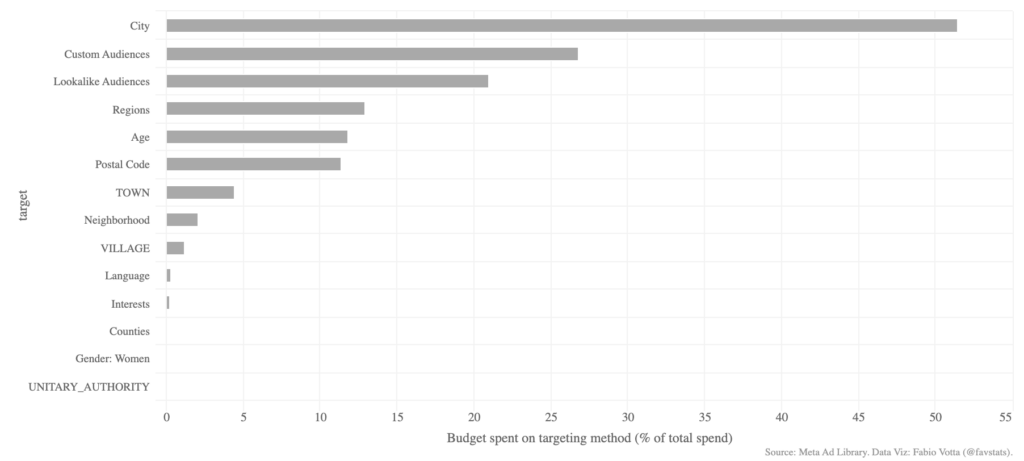With thanks to Fabio Votta, who helps us aggregate party spending on different targeting methods.
Here’s the first week of the campaign on Meta, broken down by the amount of money spent on the various targeting methods available to political advertisers.

To produce the above chart, we aggregate the amount spent on each targeting method for every known political advertiser in the UK on Meta that is active in that time period.
There are three takeaways from this:
- Geography is very important to UK political advertisers. Cities, towns, villages, regions (England, Scotland, Wales, NI) and postal codes are all extremely frequently used. Taken alone, these allow campaigns to either target the specific places they want to reach, or just as often, to prevent their ads showing up where they shouldn’t (e.g. in Scotland, where both the Conservatives and Labour run separate campaigns through their Scottish sister parties). The high prevalence of geographical targeting is reflective of the electoral system, where 650 mini-elections happen, while a national campaign is layered over the top of them.
- Custom and Lookalike Audiences, products that Meta offers which allow advertisers to use external datasets (such as their party email list or people who visited their website) and target them directly, or expand the reach of them with some algorithmic predictions about who else might be responsive to the ads, are also widely used. A quarter of political ads are powered by Custom Audiences, and 20% use Lookalike Audiences. Where parties have data on the voters they want to reach, they like to use it.
- Interest-based targeting («You’re seeing this because you like the Great British Bake Off») is much less popular than is commonly thought. Based on this data, just 0.2% of UK political ads used interests as a way to reach voters in the first week of the campaign. There are two possible reasons for this. First, it’s not straightforward to think of interests that might define a «supporter» or a «swing voter». Geography and age tend to be much better predictors of these things than anything else. Two, the parties are doing a good job of communicating this to their local campaigns who, historically have been less sophisticated in their approach, and have tended to use interest-based targeting more.
It’s worth noting that there are quite big differences between the ways the parties are targeting their ads. The Conservatives are very reliant on Custom and Lookalike Audiences, Labour prefers to target places. We’ll come back to this next week.
In the first week of the campaign, most of the digital ad spend has been from Labour and the Conservatives. There’s also been a lot of candidate spending, as those with the resources tried to push out as many ads as they could before the spending restrictions kicked in. The next week of data will see that change, as local campaigns become very restricted, and the other parties’ campaigns start to ramp up.
Takeaway: In the first week of the campaign, parties used geography to target their ads most of the time, employed voter and supporter data lists (when they have them) and seemed quite trusting of Meta’s ability to find audiences for their ads via «Lookalikes».
A note on Google:
- Google doesn’t allow Custom or Lookalike Audiences for political ads, so you can only use postal districts (e.g. BN1), age and gender for ad targeting.
